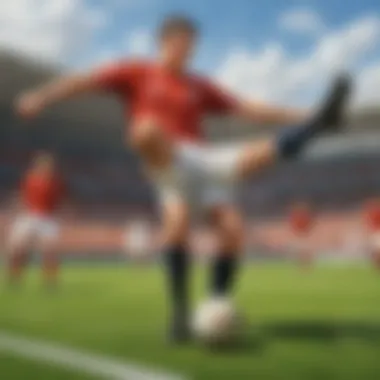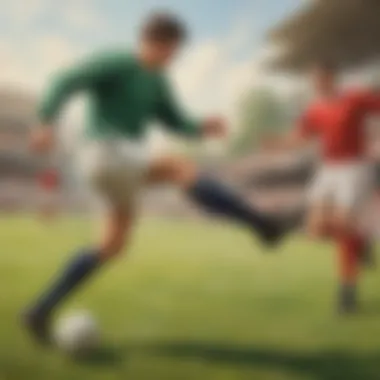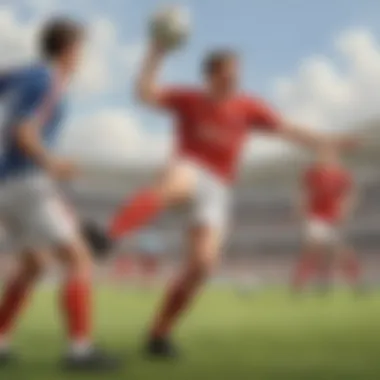Mastering the Art of Football Kicking: A Comprehensive Guide


Science Fun Facts
Discover the Wonders of Science
Peering into the intricate technique of kicking a football brings to light various scientific concepts that underpin this fundamental aspect of the game. By dissecting the physics of a kick, from the initial contact with the ball to its trajectory through the air, we unravel the magic of scientific principles in action. Through engaging educational videos and animations, we visualize the complex interplay of forces and angles that contribute to a successful kick, enhancing our grasp of the science behind this seemingly simple yet deeply intricate skill.
Science Quiz Time
Science Experiment Showcase
Understanding the Basics of Kicking
Kicking a football is an art that requires precision and technique. In this article, we delve into the fundamental aspects of kicking, exploring the biomechanics, types of kicks, and key factors for a successful kick. Understanding the basics of kicking is essential for any football player looking to improve their skills on the field. It forms the foundation upon which advanced techniques and strategies are built, making it a crucial starting point for mastering the art of kicking.
Biomechanics of a Kick
When it comes to kicking a football, the biomechanics play a crucial role in the execution of a successful kick. The role of the hip, knee, and ankle joints is paramount in generating power and accuracy. Each joint contributes to the kinetic chain that transfers energy from the body to the ball. The proper alignment and coordination of these joints determine the efficiency of a kick, emphasizing the importance of biomechanics in understanding the mechanics behind a powerful strike.
Role of the hip, knee, and ankle joints
The hip, knee, and ankle joints work synergistically to produce a cohesive kicking motion. The hip provides the initial power by extending the leg, while the knee adds precision and control to the kick. The ankle, acting as the point of contact with the ball, transfers the accumulated energy to the target. Understanding how these joints function in unison is essential for achieving optimal kicking performance.
Impact of foot position on ball trajectory
The positioning of the foot during a kick directly influences the trajectory of the ball. Whether striking with the instep, laces, or side of the foot, the angle and contact point determine the direction and spin of the ball. By adjusting the foot position, players can control the height, speed, and curve of their kicks, showcasing the significance of foot placement in achieving desired outcomes.
Importance of follow-through in a kick
Follow-through plays a pivotal role in the outcome of a kick. It ensures that the energy generated during the kick is fully transferred to the ball, maximizing power and accuracy. A complete follow-through involves extending the kicking leg beyond the point of contact, displaying proper technique and commitment to the strike. Emphasizing follow-through in a kick leads to more consistent and effective results on the pitch.
Types of Kicks
In the realm of football, various types of kicks serve different purposes and challenges for players. Understanding the characteristics and techniques of each kick is essential for expanding one's repertoire and adapting to diverse in-game scenarios. The three primary types of kicks – instep kick, swerve kick, and chip kick – offer distinct advantages and require specific skill sets for mastery.
Instep kick
The instep kick, known for its power and accuracy, involves striking the ball with the laces of the shoe. This technique is commonly used for long passes, shots on goal, and set-piece executions. Mastering the instep kick requires proper foot placement, body alignment, and follow-through to generate maximum force and precision.


Swerve kick
The swerve kick focuses on imparting spin to the ball, causing it to curve unpredictably in the air. By striking the ball off-center with the instep or outside of the foot, players can create swerving trajectories that deceive opponents and challenge goalkeepers. Perfecting the swerve kick demands meticulous foot positioning and angle adjustments to control the ball's flight path effectively.
Chip kick
The chip kick is a finesse technique utilized for lofting the ball over defenders or the goalkeeper. This delicate touch requires precise contact with the ball using the laces or toe of the boot, enabling players to execute quick, opportunistic shots in tight spaces. Developing proficiency in the chip kick involves mastering timing, elevation, and control to achieve lofted trajectories with accuracy.
Key Factors for a Successful Kick
Achieving a successful kick in football relies on mastering key factors that encompass accuracy, power, and control. These elements intertwine to determine the quality and outcome of a player's kicks, influencing match results and individual performance. By honing these essential aspects, footballers can elevate their kicking proficiency and excel in various game situations.
Accuracy
Accuracy in kicking pertains to the ability to precisely target a specific area of the ball or goal. It involves consistent contact with the desired surface of the foot and proper alignment of the body to achieve the intended destination. Improving accuracy requires focused practice on striking techniques, visualizing targets, and adjusting for external factors such as wind or pitch conditions.
Power
Power in kicking signifies the force and velocity with which the ball is struck. Generating power involves utilizing strength from the leg muscles, core stability, and explosive movement patterns. Players enhance their kicking power through strength training, plyometrics, and kinetic chain drills aimed at maximizing force production during strikes.
Control
Control in kicking refers to the ability to manage the trajectory, spin, and speed of the ball during a kick. It encompasses ball-handling skills, foot-eye coordination, and spatial awareness to dictate the direction and outcome of each strike. Developing control requires technical refinement, situational awareness, and adaptability to varying playing conditions to execute precise and effective kicks consistently.
Mastering Technique and Form
Foot Placement and Approach
Angle of Approach to the Ball
When it comes to kicking a football, the angle of approach to the ball plays a pivotal role in determining the trajectory and accuracy of the kick. The angle at which a player approaches the ball can affect the direction in which it travels significantly. By taking into account factors such as distance, speed, and intended target, players can adjust their approach angle to achieve the desired outcome. Utilizing the correct angle of approach is essential for executing various types of kicks with precision and proficiency. Players must practice and refine their approach to the ball to enhance their overall kicking performance.
Positioning of Non-Kicking Foot
The positioning of the non-kicking foot during a kick is instrumental in maintaining balance, stability, and control. Placing the non-kicking foot correctly provides a solid foundation for generating power and accuracy in the kick. By ensuring that the non-kicking foot is appropriately positioned relative to the ball and the kicking foot, players can optimize their kicking technique. This positioning allows for a seamless transfer of weight and momentum, resulting in a more controlled and effective kick. The non-kicking foot acts as a support system during the kicking motion, contributing to the player's overall balance and follow-through.
Swing and Contact


Generating Power Through Hip Rotation
Hip rotation plays a fundamental role in generating power and momentum during a kick. By engaging the hips in the kicking motion, players can capitalize on the body's natural strength and mechanics. Rotating the hips efficiently allows players to transfer energy from the lower body to the kicking foot, increasing the speed and force of the kick. This technique not only enhances the power behind the kick but also contributes to the overall fluidity and accuracy of the motion. Mastering hip rotation is essential for delivering impactful kicks consistently.
Impact of Foot Contact Point on Ball Direction
The point of contact between the foot and the ball directly influences the direction and spin of the ball upon impact. By striking the ball at different contact points, players can manipulate the trajectory and movement of the ball. Understanding how the foot interacts with the ball allows players to adjust their technique to achieve specific outcomes. Whether aiming for precision, power, or curve, the foot's contact point is a critical factor in executing diverse kicking styles effectively. Players must practice and refine their foot contact technique to control the ball's flight path with precision.
Follow-Through and Balance
Maintaining Stability Post-Kick
Maintaining stability post-kick is essential for executing a controlled and balanced movement. After striking the ball, players must focus on stabilizing their body to prevent any unnecessary deviations or loss of control. Proper follow-through involves extending the kicking leg and maintaining a stable posture throughout the kicking motion. By emphasizing balance and stability, players can ensure that their kicks are accurate and targeted. Consistency in maintaining stability post-kick leads to improved kicking performance and overall accuracy on the field.
Ensuring Proper Weight Transfer
Advanced Techniques and Strategies
Exploring advanced techniques and strategies in the realm of kicking a football is crucial for elevating one's game. These aspects delve into the intricacies of applying specific skills that can make a significant difference on the field. By honing these techniques, players can enhance their performance levels and contribute more effectively to their team. Advanced techniques not only require physical prowess but also mental sharpness to execute them successfully. With a combination of skill, strategy, and practice, mastering these advanced techniques can set players apart in the world of football.
Curve and Spin
Creating curve with foot angle
Creating curve with the foot angle is a critical skill that adds finesse and unpredictability to a player's kicks. By striking the ball at a specific angle using the inside or outside of the foot, players can make the ball curve during flight, deceiving opponents and goalkeepers. The key characteristic of utilizing foot angle for curve lies in the precise execution of the strike, manipulating the ball's trajectory to outsmart the opposition. This technique is popular for its ability to surprise defenders and create goal-scoring opportunities, adding flair to the game. While it offers a unique advantage in terms of ball control and deception, mastering curve with foot angle requires practice and precision to maximize its effectiveness.
Applying spin for unpredictable trajectory
Applying spin to the ball introduces an element of unpredictability to the kick's trajectory, making it challenging for defenders to anticipate. By imparting spin through the kicking motion, players can influence the ball's movement in mid-air, complicating the opponent's efforts to intercept or block the shot. The key characteristic of spin application lies in the control and direction it provides to the kick, allowing players to bypass defensive lines and test the goalkeeper's agility. This technique is beneficial for surprising opponents and creating scoring opportunities from unexpected angles. However, the downside of excessive spin is the potential loss of accuracy, requiring players to balance spin with precision when executing kicks.
Optimizing Power and Distance
Strengthening leg muscles for enhanced kick
Strengthening leg muscles plays a vital role in achieving powerful and long-range kicks in football. By focusing on enhancing muscle strength through targeted exercises, players can generate greater force during their kicks, increasing the speed and distance the ball travels. The key characteristic of strengthening leg muscles for kicks involves building power in the quadriceps, hamstrings, and calf muscles to generate explosive force. This technique is popular among players aiming for goal-scoring opportunities from a distance, as it allows them to strike the ball with greater velocity and accuracy. While strengthening leg muscles can boost kicking power, overtraining or muscle imbalances may pose risks such as strain or injury, necessitating a balanced training regimen.
Utilizing momentum for long-range kicks


Utilizing momentum effectively can significantly improve the distance and power of a player's kicks. By syncing the kicking motion with their body's momentum, players can harness kinetic energy to propel the ball further down the field. The key characteristic of leveraging momentum for long-range kicks lies in the timing and coordination of the kick with the body's movement, maximizing the transfer of energy from the player to the ball. This technique is renowned for enabling players to deliver goal-scoring shots from a distance with minimal physical strain. While momentum-driven kicks offer a distinct advantage in terms of distance, maintaining accuracy and control can be challenging, requiring players to balance power with precision in their strikes.
Set Pieces and Dead Ball Situations
Techniques for free kicks and penalties
Mastering techniques for free kicks and penalties is essential for capitalizing on scoring opportunities in football. By refining the approach, strike, and placement of the ball during set-piece situations, players can increase their chances of scoring and outwitting the opposition's defense. The key characteristic of mastering free kick and penalty techniques lies in the player's composure, technique, and ability to read the goalkeeper's positioning. This technique is popular for its potential to turn the tide of a match in favor of the attacking team, as well-placed and well-struck kicks often result in goals. Nonetheless, the drawback of relying solely on set-piece proficiency is the predictability it can introduce into a player's strategy, necessitating variation and innovation in executing free kicks and penalties.
Positioning and strategy for corner kicks
Understanding the nuances of positioning and strategy for corner kicks is crucial for teams looking to convert these opportunities into goals. By optimizing the placement of players inside the penalty area, delivering accurate crosses, and employing decoy runs or set plays, teams can increase their chances of scoring off corners. The key characteristic of effective corner kick strategy lies in the coordination, communication, and timing of players to execute predetermined tactics successfully. This strategy is favored for its potential to catch the opposition off guard and create scoring chances from set-piece situations. However, the challenge of corner kicks lies in the opposing team's ability to defend against them, requiring teams to develop creative and varied approaches to corner kick scenarios for sustained success.
Practicing and Improving Your Kick
In the realm of football, the importance of honing one's kicking skills cannot be overstated. Effective practice and continuous improvement are pivotal in elevating a player's game. Within the confines of this article, we delve into the fundamental aspects of practicing and enhancing your kicking abilities. The ability to strike the ball accurately, with power and control, is a cornerstone of a proficient football player. Thus, focusing on practicing and refining your kicking technique can lead to significant enhancements in overall performance. Through dedicated practice sessions, players can fine-tune their skills, gaining a deeper understanding of the nuances required for a successful kick.
Drills and Exercises
Cone Drills for Accuracy
Exploring the realm of drills and exercises tailored for enhancing kicking precision, cone drills stand out as a prominent method for sharpening accuracy. The strategic placement of cones provides visual targets for players, aiding in improving their ability to aim kicks precisely. Cone drills also promote the development of spatial awareness and foot-eye coordination, essential skills for executing accurate kicks during gameplay. The structured nature of cone drills allows players to track their progress and set measurable goals for improvement, making them an integral component of effective practice sessions in this article.
Power Training Exercises
In the pursuit of optimizing kicking strength, power training exercises play a crucial role in enhancing a player's capacity for delivering forceful kicks. These exercises focus on strengthening the leg muscles, particularly those involved in the kicking motion, to improve power output. By engaging in targeted exercises that emphasize power generation, players can boost the velocity and distance of their kicks. Power training exercises not only enhance physical capabilities but also contribute to the overall dynamism and effectiveness of a player's kicking technique within the context of this article.
Feedback and Analysis
Utilizing Video Analysis for Technique Improvement
A noteworthy method for refining kicking technique is through the utilization of video analysis. By recording and reviewing footage of kicking performances, players can gain valuable insights into their mechanics, form, and execution. Video analysis allows for a comprehensive review of each kick, enabling players to identify areas for improvement and make necessary adjustments. The visualization of one's own performance facilitates targeted skill development, transforming feedback into actionable steps for enhancement, thus serving as a valuable tool for technique refinement.
Receiving Feedback from Coaches and Peers
Seeking feedback from coaches and peers is an indispensable aspect of the learning process for improving kicking skills. Coaches provide expert guidance, offering customized feedback tailored to individual strengths and areas of development. Peer feedback, on the other hand, offers a diverse perspective and creates a collaborative environment for skill enhancement. By actively engaging with feedback from mentors and teammates, players can gain valuable insights, refine their techniques, and foster continuous improvement, making it a pivotal aspect of skill development within the context of this article.
Consistency and Mental Preparation
Developing a Pre-Kick Routine
Establishing a pre-kick routine is a practice that promotes consistency and mental readiness before executing a kick. A structured routine helps players focus their thoughts, channel their energy, and prepare both physically and mentally for the task at hand. By developing a pre-kick ritual that includes visualizing the kick, adjusting body posture, and regulating breathing, players can cultivate a sense of familiarity and confidence before each execution. Consistency in pre-kick preparation enhances performance reliability and fosters a sense of control over the kicking process within the framework of this article.
Mental Visualization for Successful Kicks
An often-overlooked yet powerful technique, mental visualization entails mentally rehearsing kicks before physically executing them. By vividly imagining the entire kicking process, from approach to contact with the ball, players can enhance muscle memory and improve their focus during actual kicks. Mental visualization not only sharpens cognitive processing related to kicking but also instills a sense of confidence and composure in players. Incorporating this mental practice into regular training routines can positively impact kicking performance, making it a valuable asset for skill refinement within this article.







